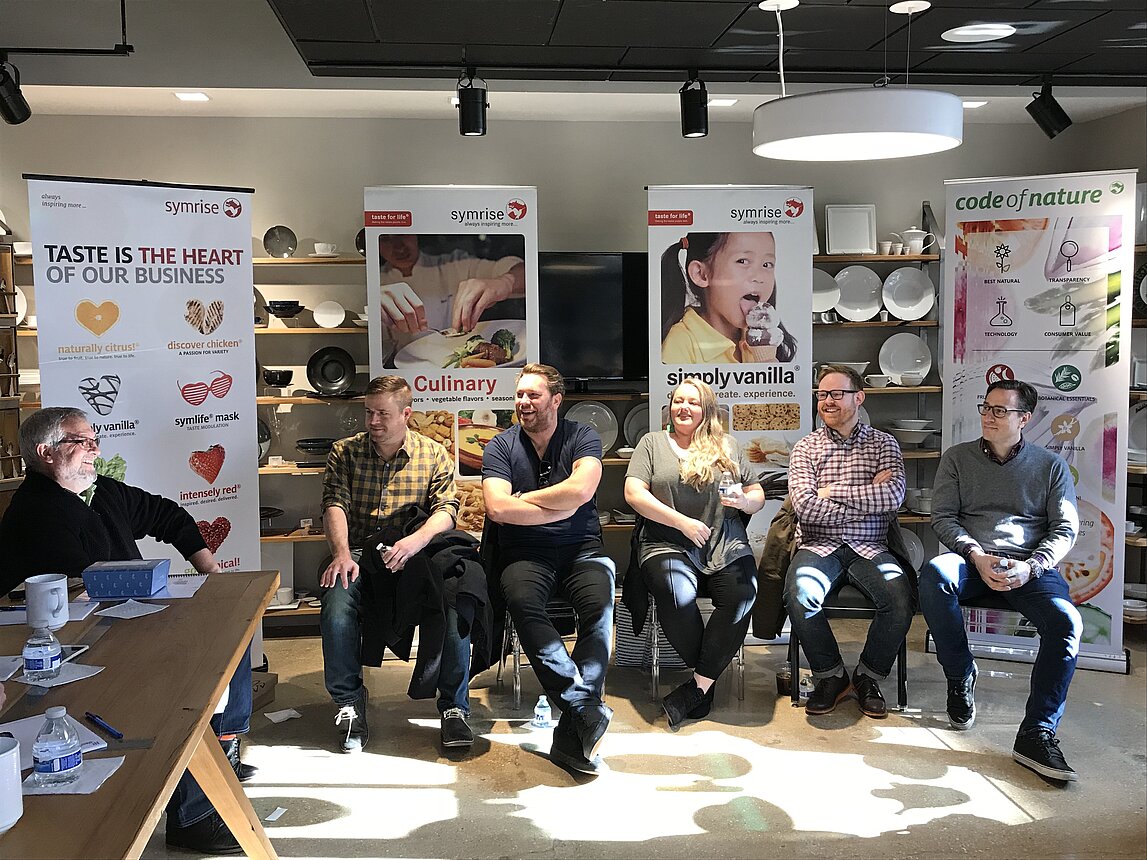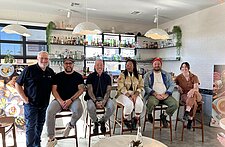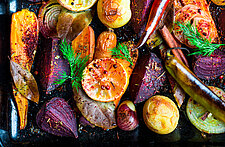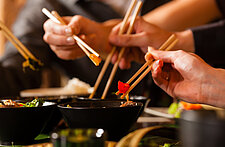With everything that’s happening in Washington, D.C. these days, it can be easy to forget that day-to-day life in the city offers a wide array of cultural experiences. A big part of this vibrancy comes from D.C.’s food scene, which offers a compelling mix of fine dining, local comfort cooking, and international influences.
Symrise brought together a dynamic panel of some of StarChefs’ 2018 Chesapeake Bay-area Rising Stars: Brad Deboy of neighborhood bakery and cafe Ellē; Drew Adams, Executive Chef of Bourbon Steak at the Four Seasons; Opie Crooks, who runs the new LINE hotel’s flagship restaurant A Rake’s Progress; Tiffany MacIsaac, Pastry Chef and Owner of ButterCream Bake Shop; and Mixologist Derek Brown of Reverie and Columbia Room.
Emmanuel Laroche, VP of Marketing and Consumer Insights at Symrise, moderated a buzzy discussion about what drives and inspires these chefs.
Almost immediately, participants pointed to the importance of local sourcing. At A Rake’s Progress, where the menu is built entirely around offerings from Mid-Atlantic farms and vendors, Opie Crooks uses creative substitutions to bridge the gap between available ingredients and consumer expectations. During the cold winter months when “it’s a struggle to get anything other than root vegetables,” Crooks improvises a shaved kohlrabi salad with smoked cheese and breadcrumbs to meet one party’s request for a kale Caesar. This substitution also extends to the restaurant’s large wedding feasts, in which clients are happy to eschew the traditional salmon for delicious local seafood like trout and rockfish.
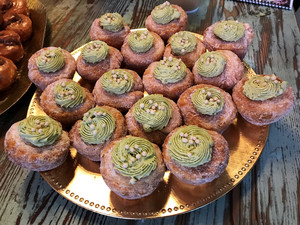 Drew Adams also attests to the D.C. area’s surprising seasonal bounty. Although imported beef from Colorado, Australia, and Japan makes up the backbone of Bourbon Steak’s menu, Adams looks to local crops for ancillary ingredients and side dishes. An avid forager, he is proud to have discovered a ramp patch the size of “ten football fields” that yields plenty of product even when restricting himself to the 10% rule of thumb for sustainable harvesting. Although harder to come by, pawpaws are also native to the region. Adams uses the creamy, vaguely tropical fruit to make desserts like ice cream and mousse.
Drew Adams also attests to the D.C. area’s surprising seasonal bounty. Although imported beef from Colorado, Australia, and Japan makes up the backbone of Bourbon Steak’s menu, Adams looks to local crops for ancillary ingredients and side dishes. An avid forager, he is proud to have discovered a ramp patch the size of “ten football fields” that yields plenty of product even when restricting himself to the 10% rule of thumb for sustainable harvesting. Although harder to come by, pawpaws are also native to the region. Adams uses the creamy, vaguely tropical fruit to make desserts like ice cream and mousse.
RELATED: 14 Emerging Ingredients From StarChefs ICC 2018 Roundtable
From here, conversation turned to some of the market’s more conceptual influences. Bound as she is to bakery staples like cupcakes and brownies, Tiffany MacIsaac admits that “50% of [ButterCream’s menu] never changes” -- but that hasn’t stopped her from creating unexpected treats like the 808 Bar, a fudgey, coconut-filled slab inspired by Canada’s popular Nanaimo bar. Says Tiffany, “the place where we really get to do unique and creative things is with wedding cakes.” MacIsaac, whose clients often host their receptions in art galleries, looks to the standing exhibits in these spaces for design inspiration; this leads her to incorporate Instagrammable ingredients like sugar pearls and gradient icing. It also opens her up to collaboration with local visual artists.
 Like MacIsaac, cocktail expert Derek Brown has also taken a multidisciplinary approach, “using everything from fermentation to foraging to techniques from restaurants” to create the surprising drinks on offer at Columbia Room. Influenced by a recent tasting in Spain, Brown extracted the essence of a hundred-year-old book by sous-viding it in grape oil; the resulting dessert-like tincture “added these richer, more complicated flavors.” He has even integrated sound waves into his drinks by mixing cocktails in quartz “singing bowls” -- objects traditionally used in Buddhist meditation. Brown says that this method creates a uniquely spiritual, holistic experience for the consumer.
Like MacIsaac, cocktail expert Derek Brown has also taken a multidisciplinary approach, “using everything from fermentation to foraging to techniques from restaurants” to create the surprising drinks on offer at Columbia Room. Influenced by a recent tasting in Spain, Brown extracted the essence of a hundred-year-old book by sous-viding it in grape oil; the resulting dessert-like tincture “added these richer, more complicated flavors.” He has even integrated sound waves into his drinks by mixing cocktails in quartz “singing bowls” -- objects traditionally used in Buddhist meditation. Brown says that this method creates a uniquely spiritual, holistic experience for the consumer.
These innovative minds wrapped up the roundtable with a discussion of emerging flavors and ingredients. In keeping with recent trends, fermentation and funk reign supreme. Brad Deboy, who points to the historical value of fermentation as a means of food preservation and survival, notes that “every single fermentation technique has an amazing story, some of them thousands of years old.” Brad points to the power of miso to transform simple onions and potatoes into a meaty, umami-rich meal. He even plans to try his hand at making a nutty soy sauce out of used, fermented coffee grounds. Powders also came up as a popular new staple, with Brad testifying to the versatility of dried, ground-up sauerkraut as a kicky seasoning. Opie Crooks, too, described the increasing popularity of earthy powders made from ingredients like smoked garlic and burnt onion.
Throughout the panel, these chefs stressed the importance of persistence and innovation. Per Drew Adams, “most of our best things have come from failures. You’ve just gotta be willing to fail… Then you come up with new techniques and flavor profiles.”
Join the In-sight community, sign up for our newsletter in 4 quick steps!
